The Relationship between the Use of Building Performance Simulation Tools by Recent Graduate Architects and the Deficiencies in Architectural Education
Abstract
1. Introduction
2. Materials and Methods
3. Results
3.1. General Research Findings: Non-Users and Users
“It is not my competence with respect to the work I develop. I work in a company where there is a team that is specifically responsible for this issue. Other team members (engineers) take care of that”.
“Given my lack of experience in this field, I believe that for the decision-making processes, an expert should help to provide reliability. Multidisciplinarity is necessary, so that simulations can be conducted by different professionals.”
3.1.1. Definition, Objective and Design Parameters
“Virtualization of the energy performance of a building optimizes the cost of its construction, operation, and reduction of its carbon footprint.”
“The control of the costs generated by the activity of the construction, from the manufacture of materials until the demolition of the building, helps avoid energy waste. It takes advantage of resources in the most efficient way, maintaining a standard of comfort for the occupants of the building.”
3.1.2. Use of Tools at Design Stages
3.1.3. University Training of BPSTs
3.1.4. Reasons for Not Using BPSTs
3.2. General Research Findings. Users
3.2.1. Selection Criteria of BPSTs
4. Conclusions
Supplementary Materials
Author Contributions
Funding
Acknowledgments
Conflicts of Interest
References
- European Renewable Energy Council. RE-Thinking 2050—A 100% Renewable Energy Vision for the European Union. 2011. Available online: http://www.erec.org/ (accessed on 25 June 2019).
- Wagner, S.; Mellblom, P. The next generation of energy efficient building design: Where are we and where should we be going? In Proceedings of the Building Enclosure Science and Technology, BEST Conference, Minneapolis, MN, USA, 10–12 June 2008. [Google Scholar]
- Cao, X.; Dai, X.; Liu, J. Building energy-consumption status worldwide and the state-of-the-art technologies for zero-energy buildings during the past decade. Energy Build. 2016, 128, 198–213. [Google Scholar] [CrossRef]
- Kazim, A.M. Assessments of primary energy consumption and its environmental consequences in the united arab emirates. Renew. Sustain. Energy Rev. 2007, 11, 426–446. [Google Scholar] [CrossRef]
- Paryudi, I. Architects and energy simulations tool. Int. J. Sci. Technol. Res. 2015, 4, 80–82. [Google Scholar]
- Attia, S.; Beltrán, L.; De Herde, A.; Hensen, J. “Architect friendly”: A comparison of ten different building performance simulation tools. In Proceedings of the IBPSA 2009–International Building Performance Simulation Association Conference and Exhibition, Glasgow, UK, 27–30 July 2009; pp. 204–211. [Google Scholar]
- Mahdavi, A. The human dimension of building performance simulation. In Proceedings of the Building Simulation 2011: 12th Conference of International Building Performance Simulation Association, Sydney, Australia, 14–16 November 2011; pp. K16–K33. [Google Scholar]
- Kusuda, T. Early history and future prospects of building system simulation. In Proceedings of Building Simulation; IBPSA: Kyoto, Japan, 1999; Available online: http://www.ibpsa.org/proceedings/BS1999/BS99_P-01.pdf (accessed on 9 September 2019).
- Hensen, J.L.M. Towards more effective use of building performance simulation in design. In Proceedings of the 7th International Conference on Design & Decision Support Systems in Architecture and Urban Planning, Eindhoven, The Netherlands, 2–5 July 2004; pp. 2–5. [Google Scholar]
- Punjabi, S.; Miranda, V. Development of an integrated building design information interface. In Proceedings of the IBPSA 2005–International Building Performance Simulation Association, Montréal, QC, Canada, 15–18 August 2005; pp. 969–976. [Google Scholar]
- Attia, S.; Hensen, J.L.M.; Beltran, L.; De Herde, A. Selection criteria for building performance simulation tools: Contrasting architects’ and engineers’ needs. J. Build. Perform. Simul. 2012, 5, 155–169. [Google Scholar] [CrossRef]
- AIA Energy Modeling Working Group. An Architect’s Guide to Integrating Energy Modeling in the Design Process. 2012. Available online: http://content.aia.org/sites/default/files/2016-04/Energy-Modeling-Design-Process-Guide.pdf (accessed on 3 February 2019).
- Mahdavi, A. People in building performance simulation. In Building Performance Simulating for Design and Operation; Routledge: Abingdon-on-Thames, UK, 2012; pp. 56–83. [Google Scholar] [CrossRef]
- Holm, D. Building thermal analyses–what the industry needs–the architects perspective. Build. Environ. 1993, 28, 405–407. [Google Scholar] [CrossRef]
- Attia, S. State of the Art of Existing Early Design Simulation Tools for Net Zero Energy Buildings: A Comparison of Ten Tools; Architecture et Climat: Louvain La Neuve, Belgium, 2011. [Google Scholar]
- Weytjens, L.; Verbeeck, G. Towards ‘architect-friendly’ energy evaluation tools. In Proceedings of the Spring Simulation Multiconference 2010, SpringSim’10, Orlando, FL, USA, 11–15 April 2010. [Google Scholar] [CrossRef]
- Soebarto, V.; Hopfe, C.J.; Crawley, D.; Rawal, R. Capturing the views of architects about building performance simulation to be used during design processes. In Proceedings of the 14th International Conference of IBPSA–Building Simulation 2015, BS 2015, Hyderabad, India, 7–9 December 2015; pp. 1480–1487. [Google Scholar]
- Naboni, E. Environmental simulation tools in architectural practice: The impact on processes, methods and design. In Proceedings of the PLEA 2013–29th Conference, Sustainable Architecture for a Renewable Future, Munich, Germany, 10–12 September 2013. [Google Scholar]
- Attia, S.; Gratia, E.; De Herde, A.; Hensen, J.L.M. Simulation-based decision support tool for early stages of zero-energy building design. Energy Build. 2012, 49, 2–15. [Google Scholar] [CrossRef]
- Mahdavi, A. Computational decision support and the building delivery process: A necessary dialogue. Autom. Constr. 1998, 7, 205–211. [Google Scholar] [CrossRef]
- Morbitzer, C.; Strachan, P.; Spires, B.; Cafferty, D.; Webster, J. Integration of building simulation into the design process of an architectural practice. In Proceedings of the Seventh International IBPSA Conference, Rio de Janeiro, Brazil, 13–15 August 2001. [Google Scholar]
- Lam, K.P.; Wong, N.H.; Feriady, H. A study of the use of performance-based simulation tools for building design and evaluation in Singapore. In Proceedings of the Sixth IBPSA Conference, Kyoto, Japan, 13–15 September 1999; pp. 675–682. [Google Scholar]
- Schlueter, A.; Thesseling, F. Building information model based energy/exergy performance assessment in early design stages. Autom. Constr. 2009, 18, 153–163. [Google Scholar] [CrossRef]
- Paradis, R. Energy Analysis Tools. Steven Winter Associates, Inc., 2010. Available online: http://Www.Wbdg.Org/Resources/Energyanalysis.Php (accessed on 15 May 2019).
- Lam, K.P.; Huang, Y.C.; Zhai, C. Energy Modeling Tools Assessment for Early Design Phase; Center for Building Performance and Diagnostics School of Architecture, Carnegie Mellon University: Pittsburgh, PA, USA, 2004. [Google Scholar]
- Bambardekar, S.; Poerschke, U. The architect as performer of energy simulation in the early design stage. In Proceedings of the IBPSA 2009–International Building Performance Simulation Association, Glasgow, UK, 27–30 July 2009; pp. 1306–1313. [Google Scholar]
- Pilgrim, M.J. The Application of Visualisation Techniques to the Process of Building Performance Analysis. Doctoral Dissertation, Loughborough University, Loughborough, UK, 2003. [Google Scholar]
- de Souza, C.B. A critical and theoretical analysis of current proposals for integrating building thermal simulation tools into the building design process. J. Build. Perform. Simul. 2009, 2, 283–297. [Google Scholar] [CrossRef]
- Brunsgaard, C.; Dvořáková, P.; Wyckmans, A.; Stutterecker, W.; Laskari, M.; Almeida, M.; Op’t Veld, P. Integrated energy design–Education and training in cross-disciplinary teams implementing energy performance of buildings directive (EPBD). Build. Environ. 2014, 72, 1–14. [Google Scholar] [CrossRef]
- Molthan-Hill, P.; Worsfold, N.; Nagy, G.J.; Leal Filho, W.; Mifsud, M. Climate change education for universities: A conceptual framework from an international study. J. Clean. Prod. 2019, 226, 1092–1101. [Google Scholar] [CrossRef]
- Janmaimool, P.; Khajohnmanee, S. Roles of Environmental System Knowledge in Promoting University Students’ Environmental Attitudes and Pro-Environmental Behaviors. Sustainability 2019, 11, 4270. [Google Scholar] [CrossRef]
- Mavromatidis, L.E.; Mavromatidi, A.; Lequay, H. The unbearable lightness of expertness or space creation in the “climate change” era: A theoretical extension of the “constructal law” for building and urban design. City Cult. Soc. 2014, 5, 21–29. [Google Scholar] [CrossRef]
- Celadyn, W. Postgraduate studies and sustainable architecture. Glob. J. Eng. Educ. 2018, 20, 54–58. [Google Scholar]
- Mavromatidis, L. Coupling architectural synthesis to applied thermal engineering, constructal thermodynamics and fractal analysis: An original pedagogic method to incorporate “sustainability” into architectural education during the initial conceptual stages. Sustain. Cities Soc. 2018, 39, 689–707. [Google Scholar] [CrossRef]
- Vehmaa, A.; Karvinen, M.; Keskinen, M. Building a More Sustainable Society? A Case Study on the Role of Sustainable Development in the Education and Early Career of Water and Environmental Engineers. Sustainability 2018, 10, 2605. [Google Scholar] [CrossRef]
- Gusc, J.; Heijes, C. “Oh This Learning, What a Thing It Is!”—Putting Sustainability First in Teaching Techniques and in Content. Sustainability 2018, 10, 2803. [Google Scholar] [CrossRef]
- Boarin, P.; Martinez-Molina, A.; Juan-Ferruses, I. Understanding students’ perception of sustainability in architecture education: A comparison among universities in three different continents. J. Clean. Prod. 2020, 248, 119237. [Google Scholar] [CrossRef]
- Alsaadani, S.; Bleil De Souza, C. Performer, consumer or expert? A critical review of building performance simulation training paradigms for building design decision-making. J. Build. Perform. Simul. 2019, 12, 289–307. [Google Scholar] [CrossRef]
- López de Asiain Alberich, M. “La Formación Medioambiental del Arquitecto”. Hacia un Programa de Docencia Basado en la Arquitectura y el Medioambiente; Universitat Politècnica de Catalunya: Barcelona, Spain, 2005. [Google Scholar]
- Oliveira, S.; Marco, E.; Gething, B.; Robertson, C. Exploring energy modelling in architecture logics of investment and risk. Energy Procedia 2017, 111, 61–70. [Google Scholar] [CrossRef]
- Oliveira, S.; Marco, E.; Gething, B.; Organ, S. Evolutionary, not revolutionary–logics of early design energy modelling adoption in UK architecture practice. Archit. Eng. Des. Manag. 2017, 13, 168–184. [Google Scholar] [CrossRef]
- Oxman, R. Digital architecture as a challenge for design pedagogy: Theory, knowledge, models and medium. Des. Stud. 2008, 29, 99–120. [Google Scholar] [CrossRef]
- Urquidi-Martín, A.; Tamarit-Aznar, C.; Sánchez-García, J. Determinants of the Effectiveness of Using Renewable Resource Management-Based Simulations in the Development of Critical Thinking: An Application of the Experiential Learning Theory. Sustainability 2019, 11, 5469. [Google Scholar] [CrossRef]
- Charles, P.P.; Thomas, C.R. Four approaches to teaching with building performance simulation tools in undergraduate architecture and engineering education. J. Build. Perform. Simul. 2009, 2, 95–114. [Google Scholar] [CrossRef]
- Reinhart, C.F.; Dogan, T.; Ibarra, D.; Samuelson, H.W. Learning by playing–teaching energy simulation as a game. J. Build. Perform. Simul. 2012, 5, 359–368. [Google Scholar] [CrossRef]
- Aksit, O.; Wiebe, E.N. Exploring force and motion concepts in middle grades using computational modeling: A classroom intervention study. J. Sci. Educ. Technol. 2019. [Google Scholar] [CrossRef]
- Khan, S. New pedagogies on teaching science with computer simulations. J. Sci. Educ. Technol. 2011, 20, 215–232. [Google Scholar] [CrossRef]
- Sherman, G.; Byers, A.; Rapp, S. Evaluation of online, on-demand science professional development material involving two different implementation models. J. Sci. Educ. Technol. 2008, 17, 19–31. [Google Scholar] [CrossRef][Green Version]
- Zucker, A.A.; Hug, S.T. Teaching and learning physics in a 1: 1 laptop school. J. Sci. Educ. Technol. 2008, 17, 586–594. [Google Scholar] [CrossRef]
- Hetherington, R.; Laney, R.; Peake, S.; Oldham, D. Integrated building design, information and simulation modelling: The need for a new hierarchy. In Proceedings of the Building Simulation 2011: 12th Conference of International Building Performance Simulation Association, Sydney, Australia, 14–16 November 2011; pp. 2241–2248. [Google Scholar]
- Tupper, K.; Franconi, E.; Chan, C.; Hodgin, S.; Buys, A.; Jenkins, M. Building energy modeling: Industry-wide issues and potential solutions. In Proceedings of the 12th Conference of International Building Performance Simulation Association, Sydney, Australia, 14–16 November 2011. [Google Scholar]
- Fernandez-Antolin, M.-M.; del-Río, J.-M.; Gonzalez-Lezcano, R.-A. Influence of Solar Reflectance and Renewable Energies on Residential Heating and Cooling Demand in Sustainable Architecture: A Case Study in Different Climate Zones in Spain Considering Their Urban Contexts. Sustainability 2019, 11, 6782. [Google Scholar] [CrossRef]
- Jesús, F.-M.; Irene, P.-C.; Roberto Alonso, G.-L.; Cristina, P.; Víctor, E.; Rafael, A.; Alberto, M. Methodology for the Study of the Envelope Airtightness of Residential Buildings in Spain: A Case Study. Energies 2018, 11, 704. [Google Scholar] [CrossRef]
- Feijó-Muñoz, J.; González-Lezcano, R.A.; Poza-Casado, I.; Padilla-Marcos, M.Á.; Meiss, A. Airtightness of residential buildings in the Continental area of Spain. Build. Environ. 2019, 148, 299–308. [Google Scholar] [CrossRef]
- Hayden, I. An evaluation of the design and use of applied visual interactive resources for teaching building regulations in higher education built environment programmes. Archit. Eng. Des. Manag. 2019, 15, 159–180. [Google Scholar] [CrossRef]
- Fernandez-Antolin, M.; del Río, J.M.; Costanzo, V.; Nocera, F.; Gonzalez-Lezcano, R. Passive design strategies for residential buildings in different spanish climate zones. Sustainability 2019, 11, 4816. [Google Scholar] [CrossRef]
- Herranen, J.; Vesterinen, V.-M.; Aksela, M. From Learner-Centered to Learner-Driven Sustainability Education. Sustainability 2018, 10, 2190. [Google Scholar] [CrossRef]
- Marcu, S. Refugee Students in Spain: The Role of Universities as Sustainable Actors in Institutional Integration. Sustainability 2018, 10, 2082. [Google Scholar] [CrossRef]
- Carrera, J.; Ramírez-Hernández, D. Innovative Education in MOOC for Sustainability: Learnings and Motivations. Sustainability 2018, 10, 2990. [Google Scholar] [CrossRef]
- Altomonte, S.; Rutherford, P.; Wilson, R. Mapping the way forward: Education for sustainability in architecture and urban design. Corp. Soc. Responsib. Environ. Manag. 2014, 21, 143–154. [Google Scholar] [CrossRef]
- Domenica Iulo, L.; Gorby, C.; Poerschke, U.; Nickolas Kalisperis, L.; Woollen, M. Environmentally conscious design–educating future architects. Int. J. Sustain. High. Educ. 2013, 14, 434–448. [Google Scholar] [CrossRef]
- EDUCATE. 2009. Available online: http://cort.as/-EURy (accessed on 5 March 2019).
- Pallant, J. SPSS Survival Manual: A Step by Step Guide to Data Analysis Using SPSS for Windows; McGraw-Hill Education, Open University Press: New York, NY, USA, 2007; ISBN 10-0-335-22366-4. [Google Scholar]
- Denzin, N.; Lincoln, Y. The Sage Handbook of Qualitative Research; Sage: Thousand Oaks, CA, USA, 2005. [Google Scholar]
- Keller, J.M. Motivational Design for Learning and Performance: The ARCS Model Approach; Springer: Berlin/Heidelberg, Germany, 2009. [Google Scholar]
- Guilford, J.P. Fundamental Statistics in Psychology and Education; McGraw-Hill: New York, NY, USA, 1950. [Google Scholar]
- Baba, A.; Mahjoubi, L.; Olomolaiye, P.; Booth, C. Architects requirements of decision support tools to deliver low impact housing design in the UK: Insights and recommendations. J. Environ. Earth Sci. 2013, 3, 22–32. [Google Scholar]
- Weytjens, L.; Attia, S.; Verbeeck, G.; De Herde, A. The ‘architect-friendliness’ of six building performance simulation tools: A comparative study. Int. J. Sustain. Build. Technol. Urban Dev. 2011, 2, 237–244. [Google Scholar] [CrossRef]
- Attia, S. Building Performance Simulation Tools: Selection Criteria and User Survey; Architecture et Climat: Louvain La Neuve, Belgium, 2010. [Google Scholar]
- Zapata-Lancaster, G.; Tweed, C. Tools for low-energy building design: An exploratory study of the design process in action. Archit. Eng. Des. Manag. 2016, 12, 279–295. [Google Scholar] [CrossRef]
- Mahdavi, A.; Feurer, S.; Redlein, A.; Suter, G. An inquiry into the building performance simulation tools usage by architects in Austria. In Proceedings of the Eight International IBPSA Conference, Eindhoven, The Netherlands, 11–14 August 2003; pp. 777–784. [Google Scholar]
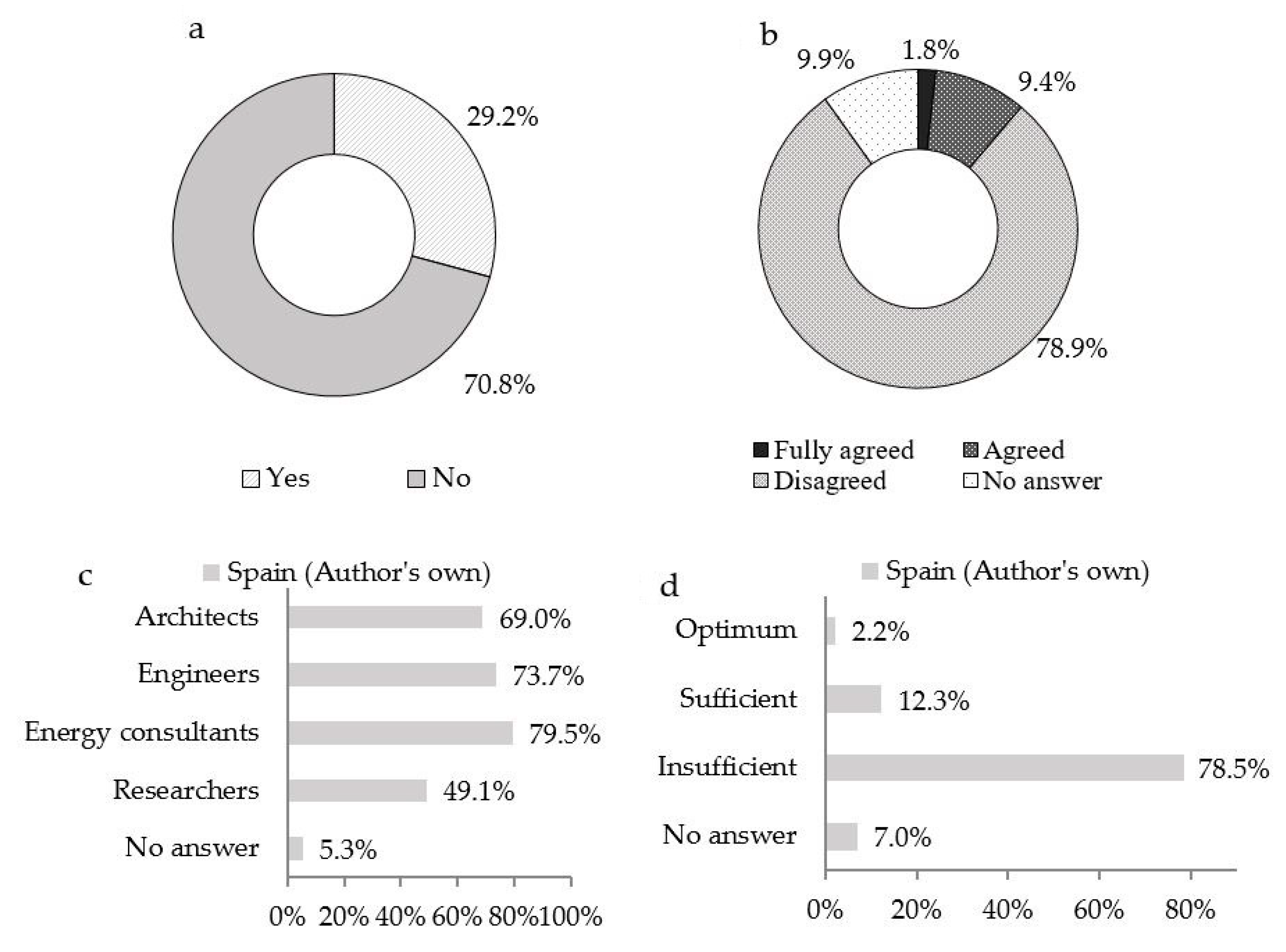
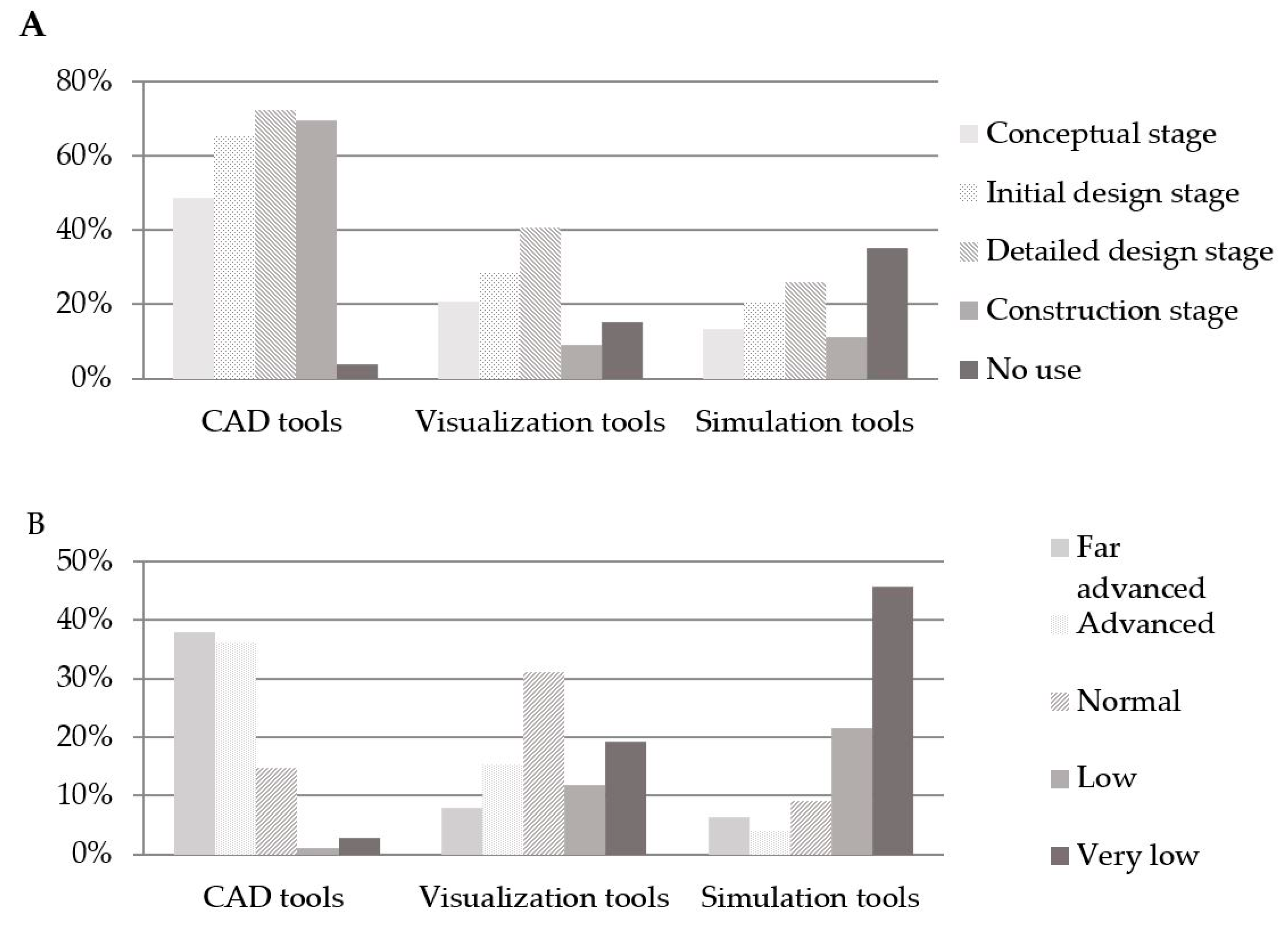
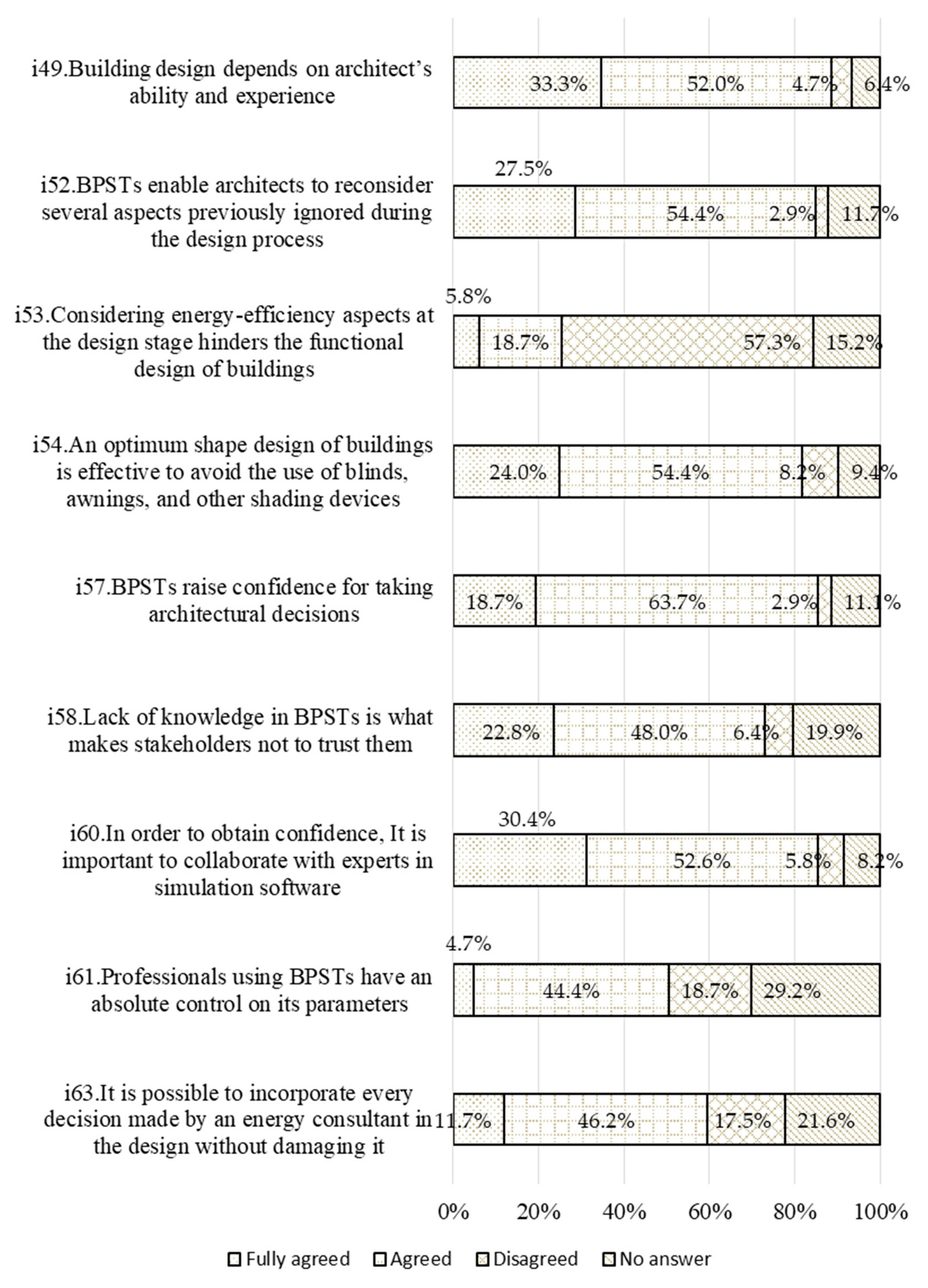
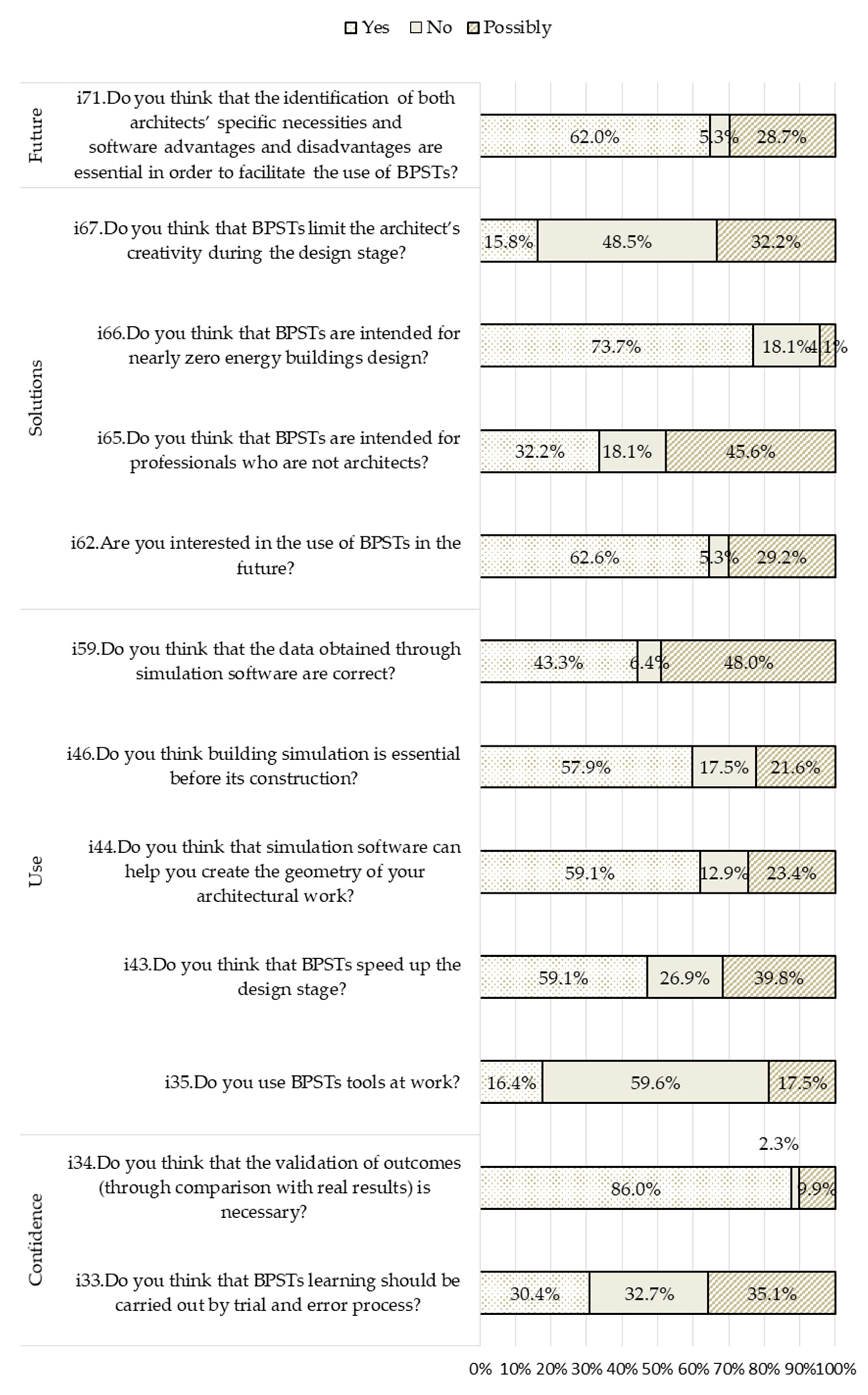
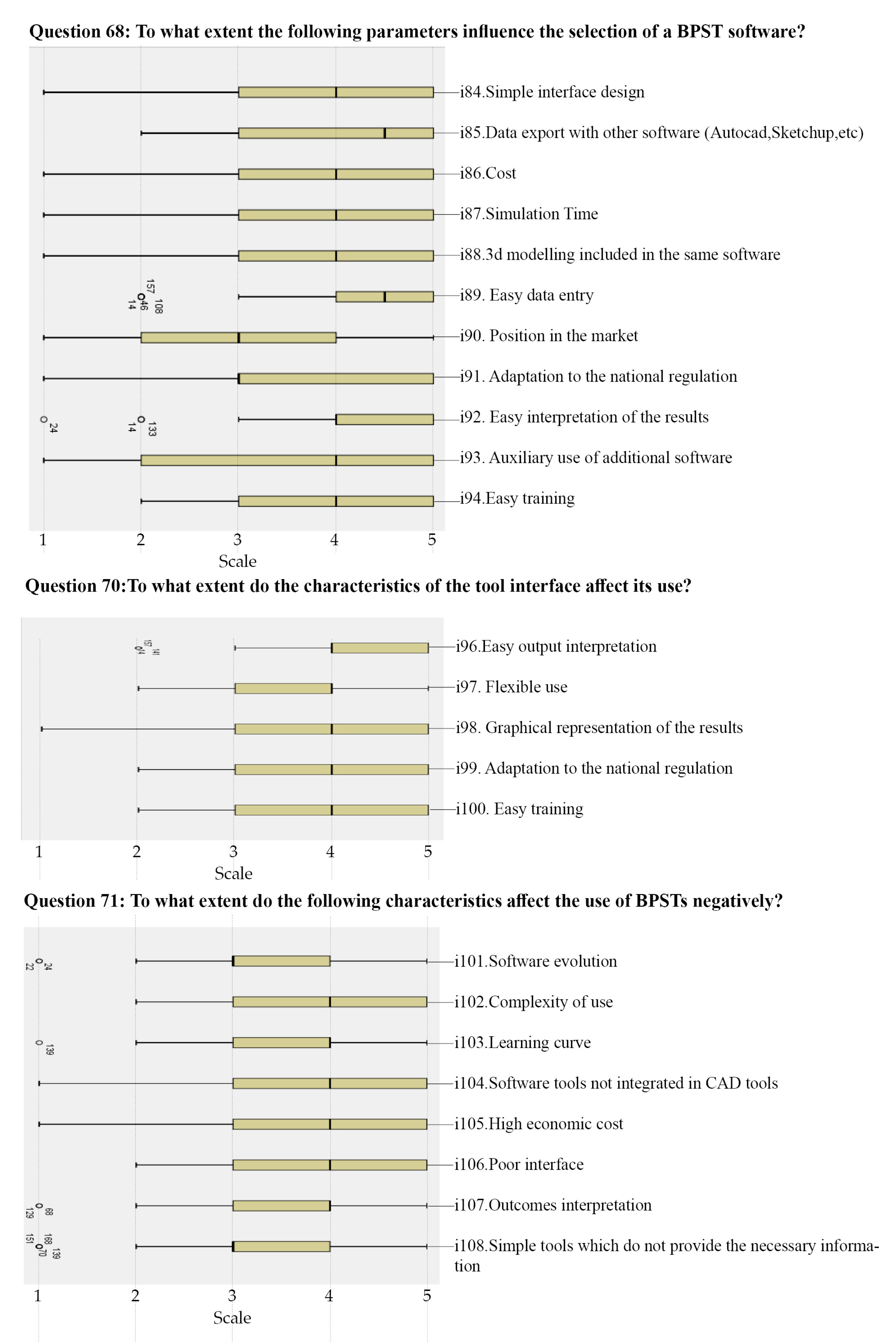
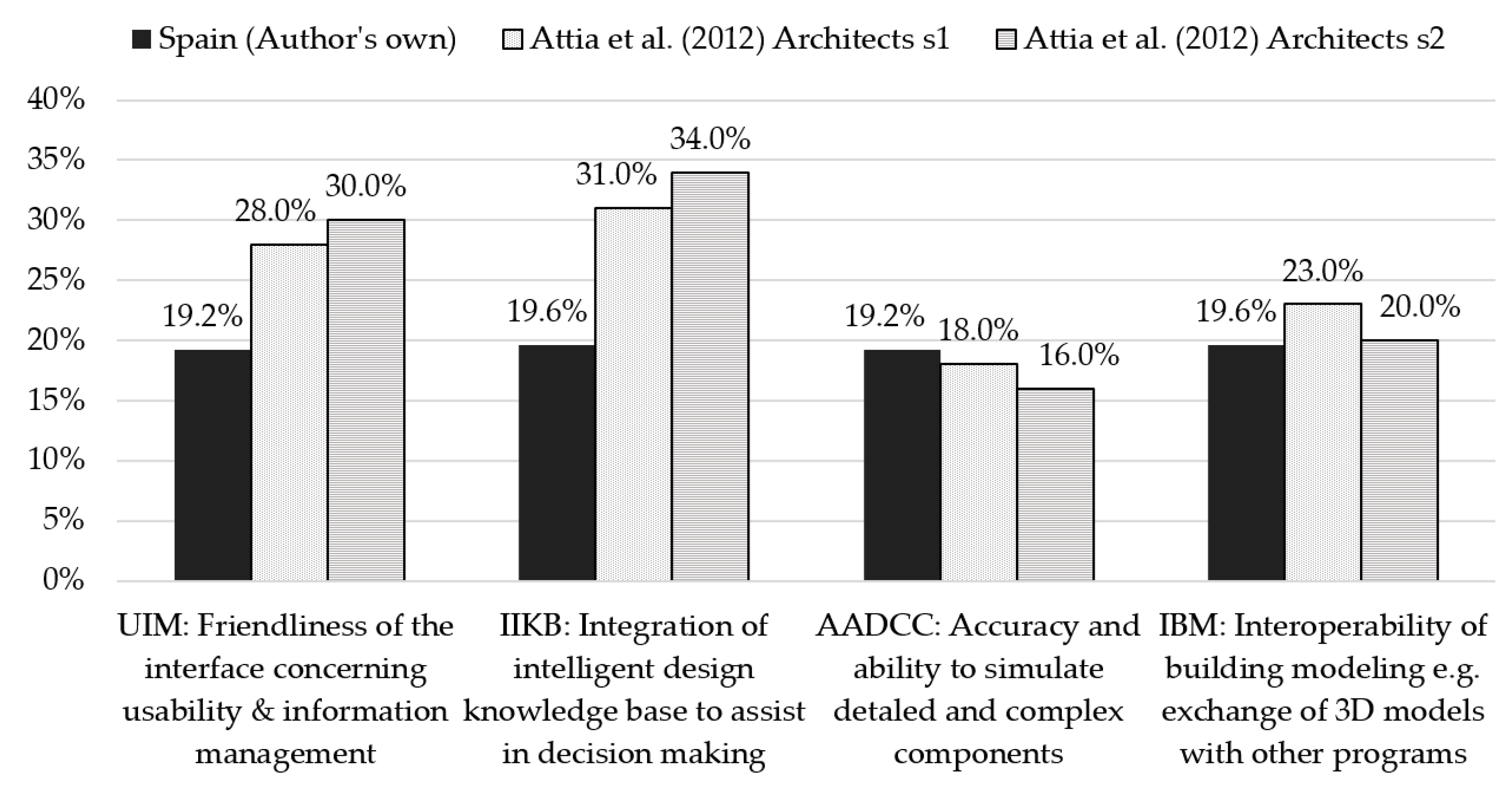
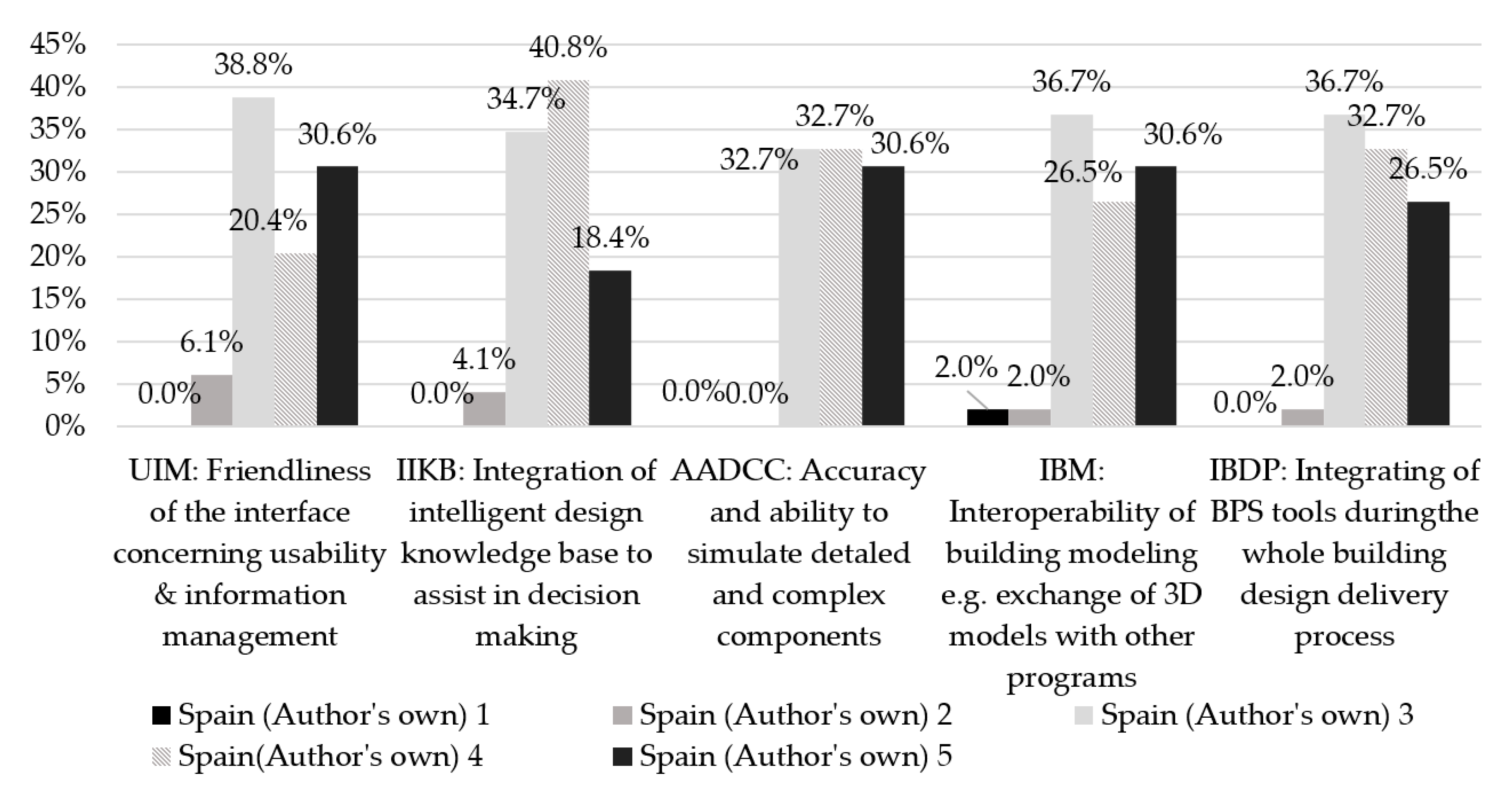
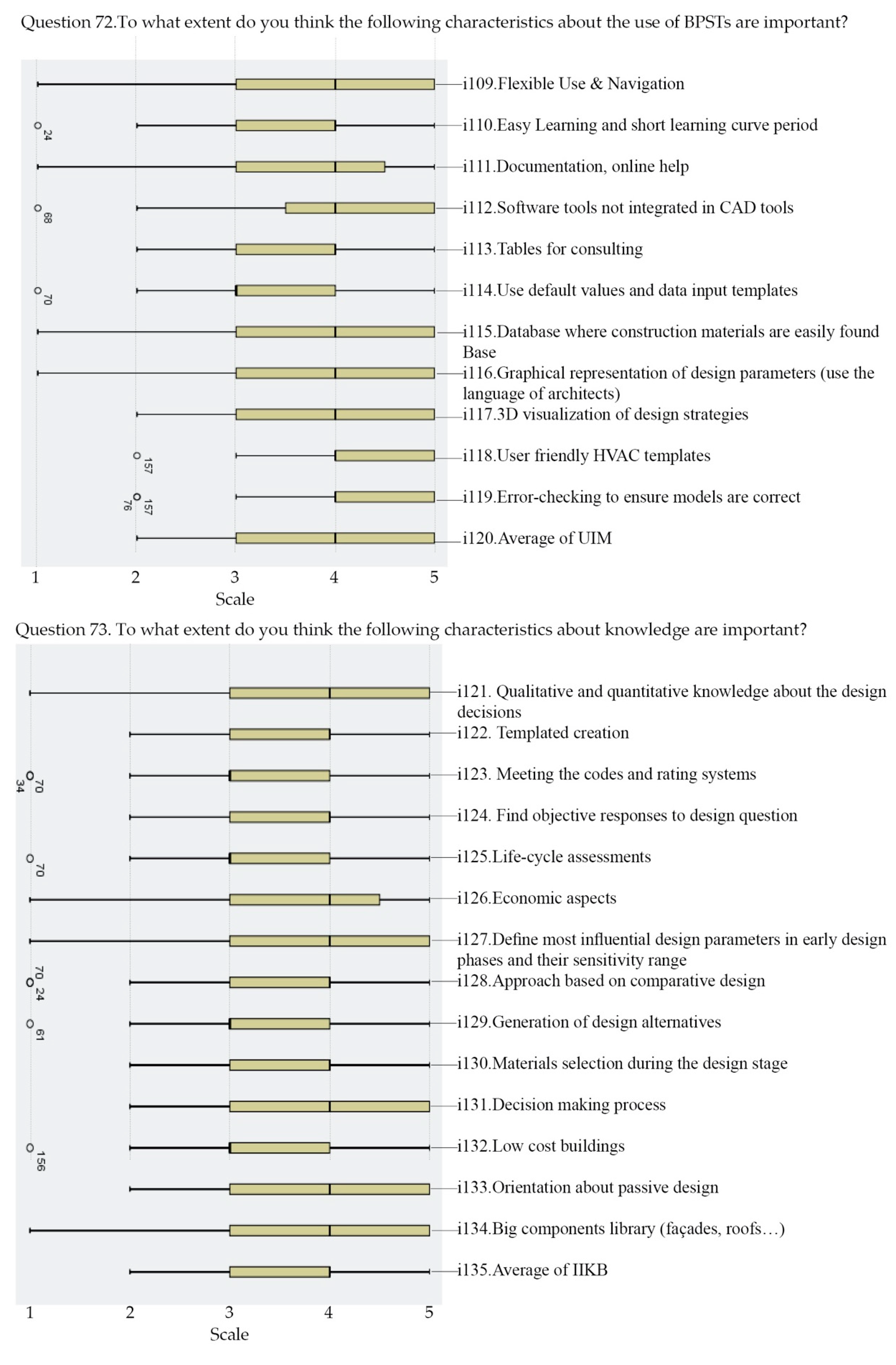
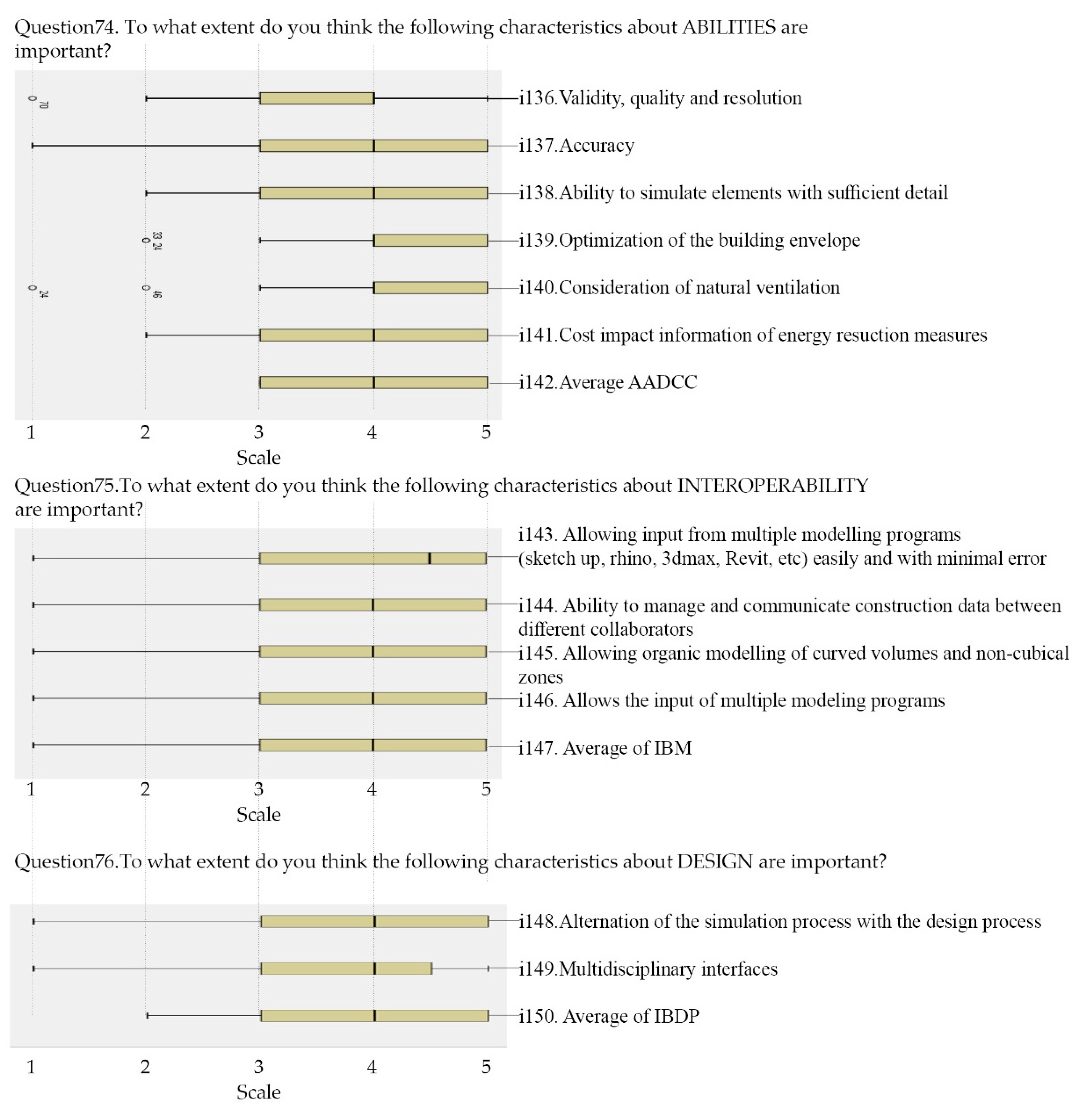
© 2020 by the authors. Licensee MDPI, Basel, Switzerland. This article is an open access article distributed under the terms and conditions of the Creative Commons Attribution (CC BY) license (http://creativecommons.org/licenses/by/4.0/).
Share and Cite
Fernandez-Antolin, M.-M.; del-Río, J.-M.; del Ama Gonzalo, F.; Gonzalez-Lezcano, R.-A. The Relationship between the Use of Building Performance Simulation Tools by Recent Graduate Architects and the Deficiencies in Architectural Education. Energies 2020, 13, 1134. https://doi.org/10.3390/en13051134
Fernandez-Antolin M-M, del-Río J-M, del Ama Gonzalo F, Gonzalez-Lezcano R-A. The Relationship between the Use of Building Performance Simulation Tools by Recent Graduate Architects and the Deficiencies in Architectural Education. Energies. 2020; 13(5):1134. https://doi.org/10.3390/en13051134
Chicago/Turabian StyleFernandez-Antolin, Maria-Mar, José-Manuel del-Río, Fernando del Ama Gonzalo, and Roberto-Alonso Gonzalez-Lezcano. 2020. "The Relationship between the Use of Building Performance Simulation Tools by Recent Graduate Architects and the Deficiencies in Architectural Education" Energies 13, no. 5: 1134. https://doi.org/10.3390/en13051134
APA StyleFernandez-Antolin, M.-M., del-Río, J.-M., del Ama Gonzalo, F., & Gonzalez-Lezcano, R.-A. (2020). The Relationship between the Use of Building Performance Simulation Tools by Recent Graduate Architects and the Deficiencies in Architectural Education. Energies, 13(5), 1134. https://doi.org/10.3390/en13051134







